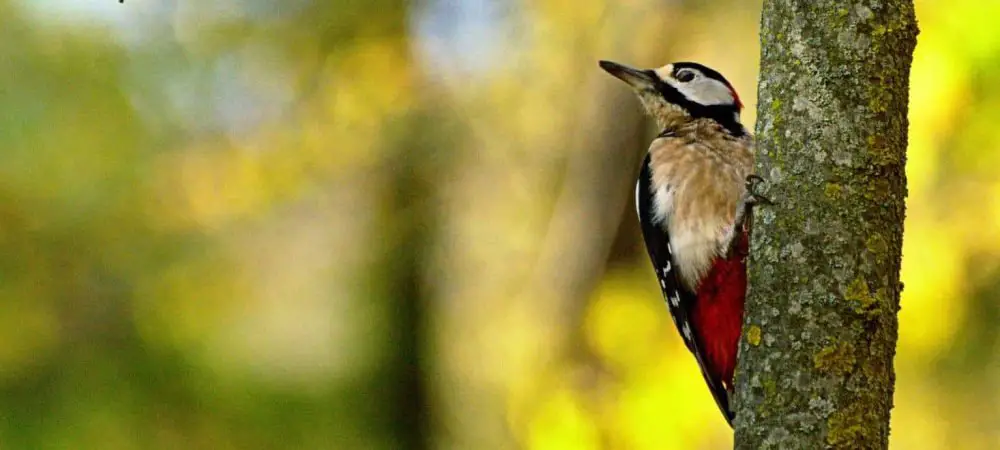
In California, it is possible to spot 16 different species of woodpecker. These are:
- Northern Flicker
- Nuttall’s Woodpecker
- Acorn Woodpecker
- Downy Woodpecker
- White-headed Woodpecker
- Hairy Woodpecker
- Red-breasted Sapsucker
- Pileated Woodpecker
- Ladder-backed Woodpecker
- Lewis’s Woodpecker
- Williamson’s Sapsucker
- Red-naped Sapsucker
- Yellow-bellied Sapsucker
- Gila Woodpecker
- Black-backed Woodpecker
- Red-headed Woodpecker
Want to learn more? Take a look at the North American Guide to Woodpeckers
California is a West Coast state in the United States that expands from the Mexican border to the Pacific Ocean.
California is an ideal destination for residents, tourists, and an incredible population of wildlife.
This state’s dynamic landscape displays popular beaches, forests, mountains, deserts, and valleys.
California is also praised for its pleasant, Mediterranean climate that features typically dry summers and cool, mild winters.
Due to California’s location near the sea, it’s climate remains steady throughout the state.
It may come as no surprise that this beautiful state boasts 280 state parks! California’s state park system is actually one of the largest and most diverse in the world.
A wide range of 16 woodpecker species live throughout the state of California.
Below you will discover profiles for each species of woodpecker along with their preferred habitats.
While in California, you’re sure to see the Northern Flicker, while you may not readily observe the Red-headed Woodpecker.
Take a look at our article on How to Attract Woodpeckers?
What Woodpeckers can be seen in California?
Table of Contents
1. Downy Woodpecker
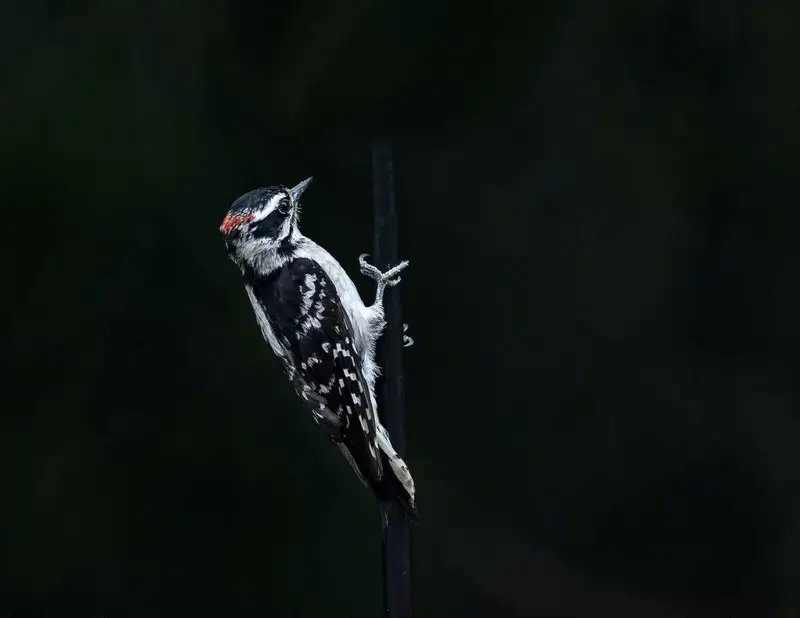
Wingspan
3.27 to 4.13 inches
Weight
0.75 to 1 ounce
Life Expectancy
12 Years
Diet
Insects & Non-insect arthropods
Downy Woodpeckers are a particularly tiny species of woodpecker.
These birds generally have notable black and white feather patterns, and the males are recognized by the red feathers at the crowns of their heads.
Downy Woodpeckers nest in the holes of large trees while they frequently visit residential areas in search of backyard bird feeders.
You’ll recognize this species by its loud, quick drumming pattern on trees and posts.
This repetitive drumming is usually done in order to attract a mate’s attention during breeding season in April and May. Another way to identify these birds is by their high-pitched whine sounding call.
2. Hairy Woodpecker
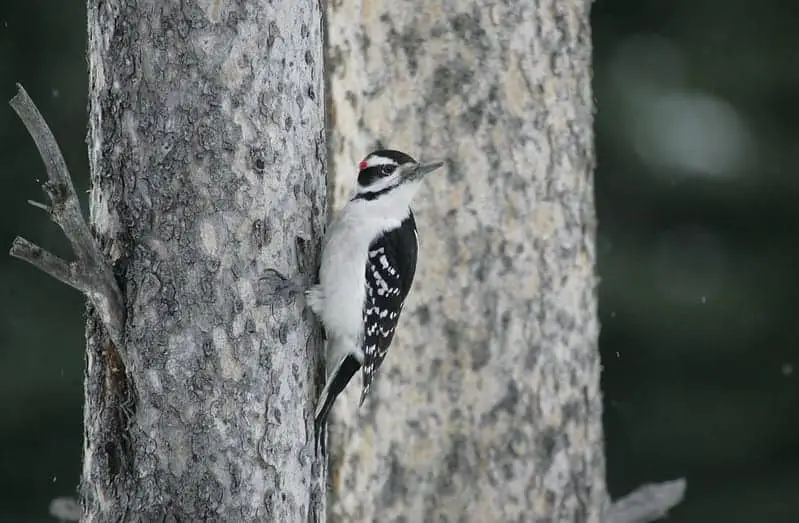
Wingspan
15 inches
Weight
1.4 to 3.4 ounces
Life Expectancy
15 years
Diet
Wood-boring insects & tree sap
Hairy Woodpeckers are medium in size and are distinctly recognized for their long, straight, bills that are nearly the same length of their heads.
These woodpeckers usually have dark feathers on their wings and backs with white colored feathers on their bellies.
You’ll also notice the adult male woodpeckers with a red-orange cap on their heads.
Hairy Woodpeckers can be seen at the trunks of medium to large sized trees in California’s woodlands during breeding season as they search for food and excavate nests.
You can identify these woodpeckers by the high octave conflict call given by the male birds.
3. Pileated Woodpecker
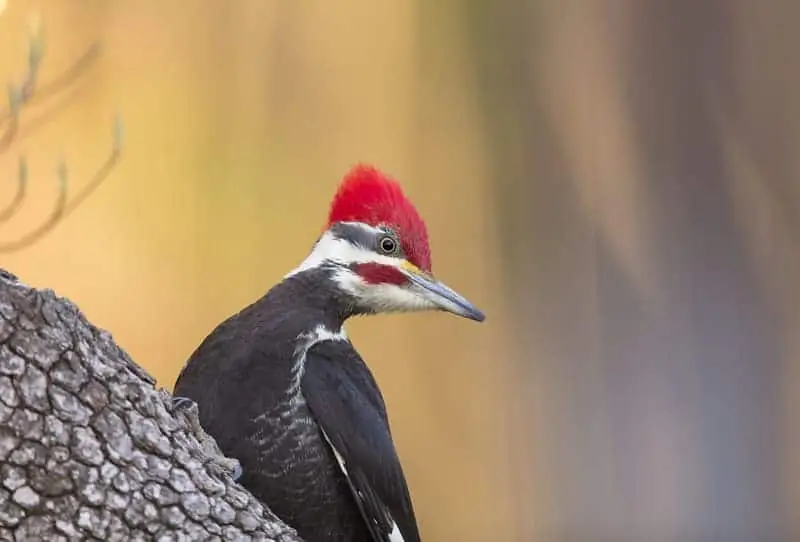
Wingspan
26 to 30 inches
Weight
8.8 to 14.1 ounces
Life Expectancy
13 years
Diet
Fruit, nuts & insects
Pileated Woodpeckers are large birds, being the second largest woodpecker species in the entire United States.
These are most likely the largest woodpeckers in the California area. These woodpeckers are an overall black color with the exception of their white necks and red barring on the tops of their heads.
Pileated Woodpeckers prefer to take habitat in a more dense forested area with large trees.
In California, they usually prefer an old growth habitat to create excavations in dead trees during late March and early April.
These woodpeckers tend to be more vocal with a high-pitched series of piping calls.
4. Yellow-bellied Sapsucker
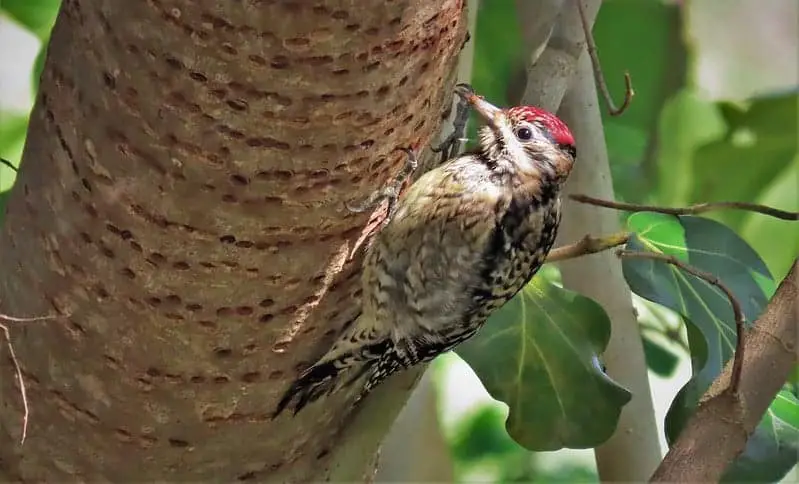
Wingspan
13 to 16 inches
Weight
1.5 to 1.9 ounces
Life Expectancy
7 years
Diet
Tree sap, insects & fruit
Yellow-Bellied Sapsuckers are classified as medium sized birds that are widely recognized by their shoulder stripe.
The mature males of this species are known for their red foreheads and throats, while the females display white throats.
Yellow-bellied Sapsuckers are appropriately named for their pale, yellow bellies. These woodpeckers prefer to nest in conifer forests, where they build their home in the cavities of tall trees.
You’ll most likely find these birds during the spring and summer months in open woodland areas. Yellow-Bellied Sapsuckers are monogamous, breeding with their long-term mates each season.
They can be easily identified by their scratchy, nasal call that resembles a meowing sound.
5. Northern Flicker
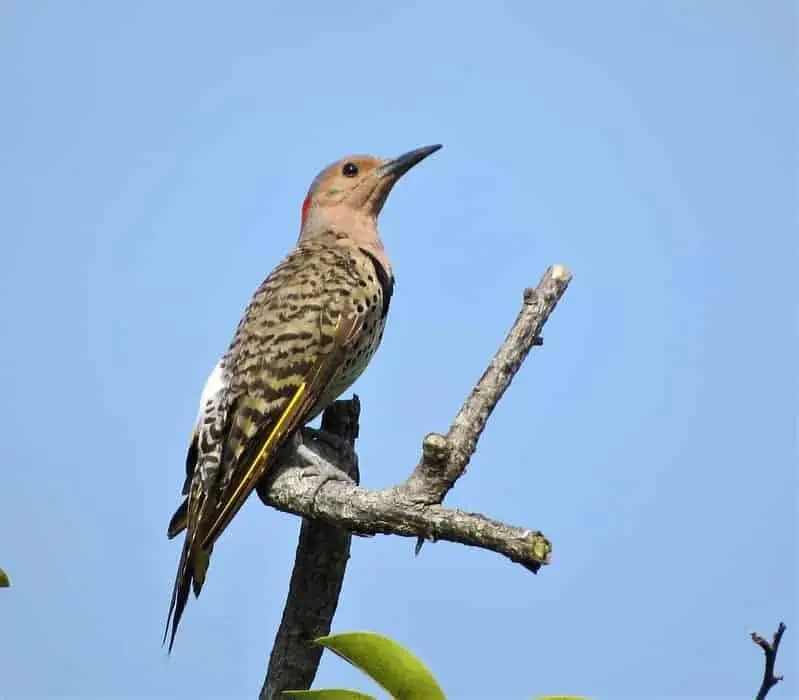
Wingspan
21.3 inches
Weight
6 ounces
Life Expectancy
9 Years
Diet
Insects, seeds, nuts & fruit
Northern Flickers are identified as large birds, in fact, they are the third largest woodpecker in North America.
California is home to the West Coast variant of Northern Flicker, called the Red-shafted Northern Flicker.
The name refers to the beautiful red color of their underwings and undertails. Flickers are typically brown with black feathers adorning their backs with some dark spotting on their underbellies, and a black crescent shape on the breast.
Northern Flickers can be seen in California while they are digging in the ground near grassy areas searching for ants.
These woodpeckers also make their homes among woodlands in close proximity to dead trees during breeding season from March to June.
Northern Flickers can also be easily spotted in California’s residential areas. You’ll recognize this species of woodpecker by their repetition of ‘wake-up’ sounding calls.
6. Lewis's Woodpecker
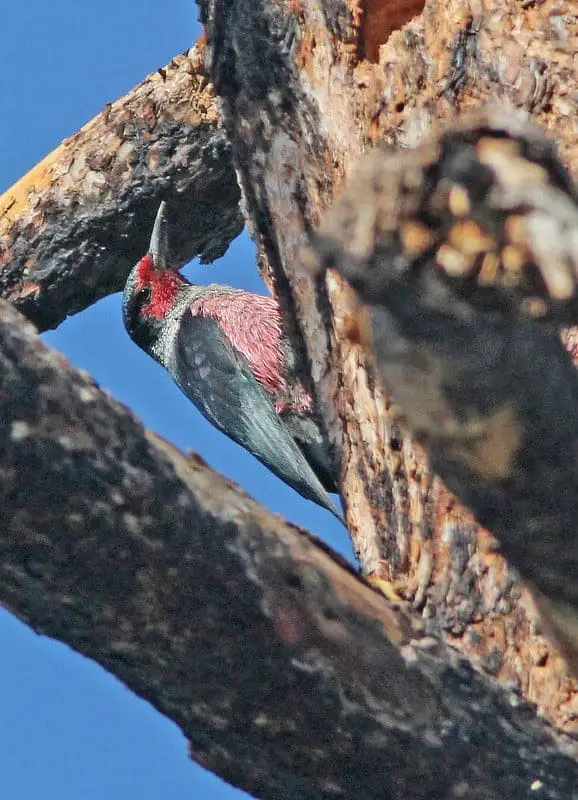
Wingspan
11 inches
Weight
4 ounces
Life Expectancy
4-11 Years
Diet
Insects & Nuts
Lewis’s Woodpeckers are large birds with striking colored feather patterns.
These birds have red faces with dark green and glossy backs, pastel colored necks, and light pink feathers on their bellies.
However, the juvenile woodpeckers are a dull, brown color. These woodpeckers have very unique characteristics that are unlike the other species.
For example, when Lewis’s Woodpeckers are in flight, they resemble the flight pattern of a crow.
These woodpeckers even catch their prey while in mid-air which is quite contrary to the typical foraging behavior of a woodpecker.
Lewis’s Woodpeckers prefer mountains and large areas of old growth forests, with Ponderosa Pines being their top choice.
These woodpeckers are known for an alarming ‘churr’ call that the males often make during courtship rituals.
7. Red-headed Woodpecker
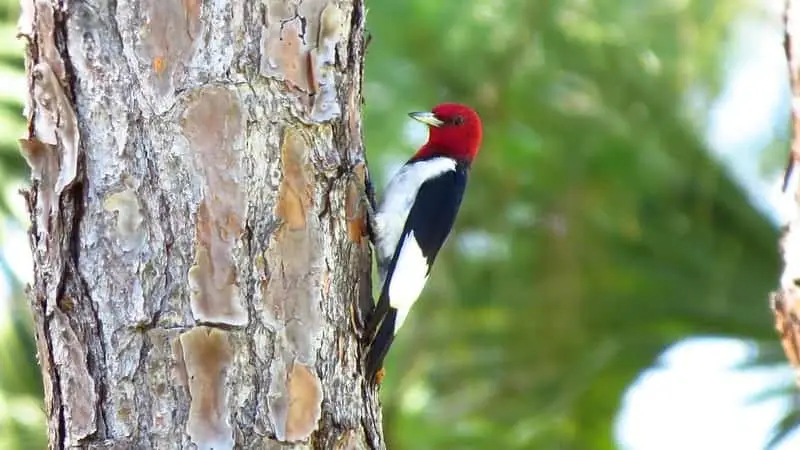
Wingspan
16 inches
Weight
2.5 ounces
Life Expectancy
9 Years
Diet
Insects & Berries
Red-Headed Woodpeckers are a medium species of woodpecker with white feathers and contrasting dark wings, while they are named for their bright red heads.
These woodpeckers tend to live in a wide variety of areas including open woodlands, forests, cottonwoods, fields, and residential areas.
Red-headed Woodpeckers build their nests in dead trees near the ground for foraging. You can observe these woodpeckers in the spring and summer months as they are seen flying through the air catching insects.
It is important to take caution while observing these birds due to their defensive behavior. You can identify these woodpeckers by their loud chirps and cackles.
8. Black-backed Woodpecker
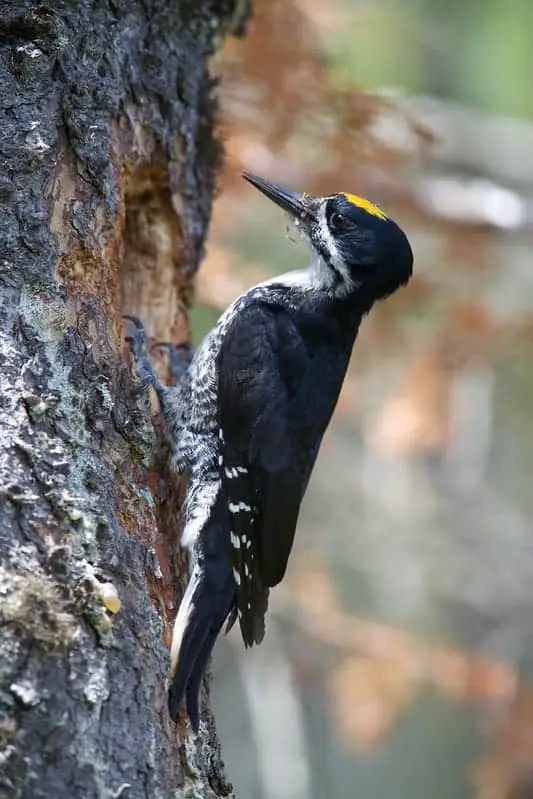
Wingspan
16 inches
Weight
2.5 ounces
Life Expectancy
8 Years
Diet
Wood-boring Beatles, fruit & nuts
Black-backed Woodpeckers are medium sized, often recognized by their glossy black backs with faint white markings on their flight feathers.
They also display black heads with the exception of a white mustache stripe and throat.
Adult males are distinguished by the yellow caps on their heads.
These woodpeckers prefer to take habitat in forests, particularly, forests that have been damaged by fires.
These birds tend to be a bit more inconspicuous, as their population fluctuates based on the availability of food.
You’ll most likely see them in their preferred habitats in the spring and early summer months. These woodpeckers are easily identified by their short ‘pick’ call that has a unique clicking tone.
9. Williamson's Sapsucker
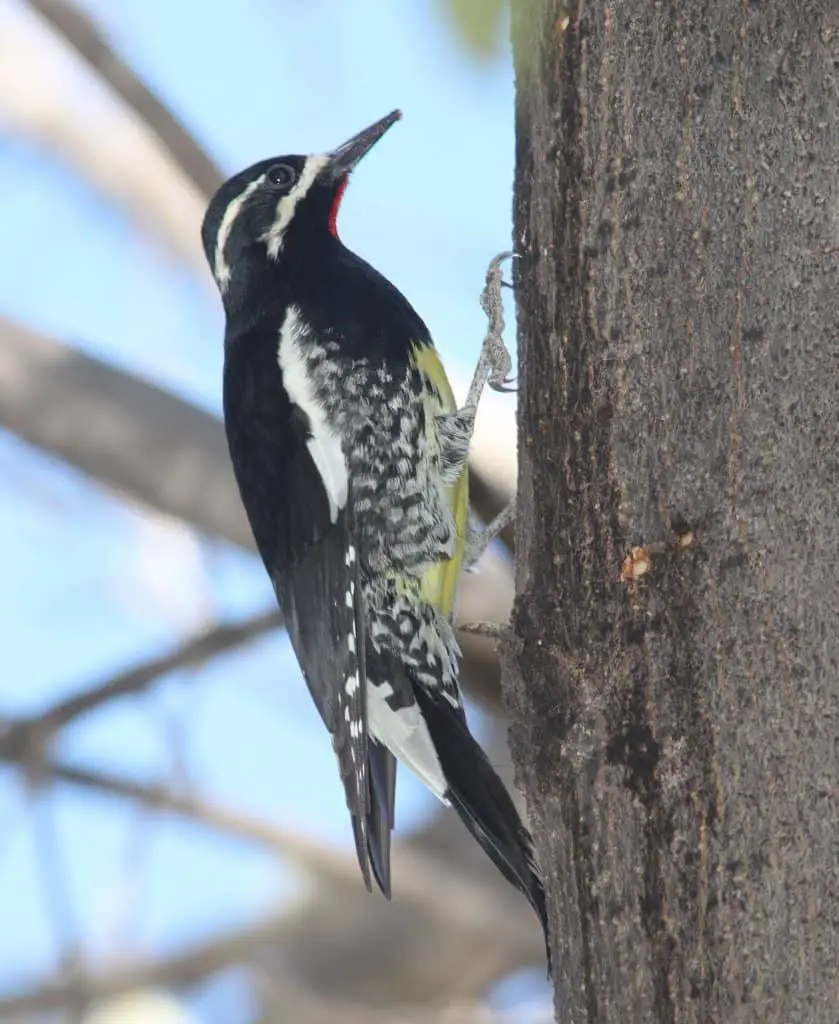
Wingspan
13.4-15.8 inches
Weight
44-55 g
Life Expectancy
7 Years
Diet
Sap
Williamson’s Sapsuckers are medium sized with bold feather patterns.
The adult males are black with bright white feathers along their wings and white slashes on their faces.
These woodpeckers also have notable red throats and yellow bellies.
The females can be easily distinguished due to their brown heads, dark breast, and the black and white patterns on their backs and wings.
These birds take habitat in mountain areas such as the Rocky Mountains, the Cascades and the Sierra Nevada.
They are also common in coniferous and mixed woodlands where there are mature trees. Williamson Sapsuckers are known for their wheeze sounding ‘chyaah’ call.
10. Red-Naped Sapsucker
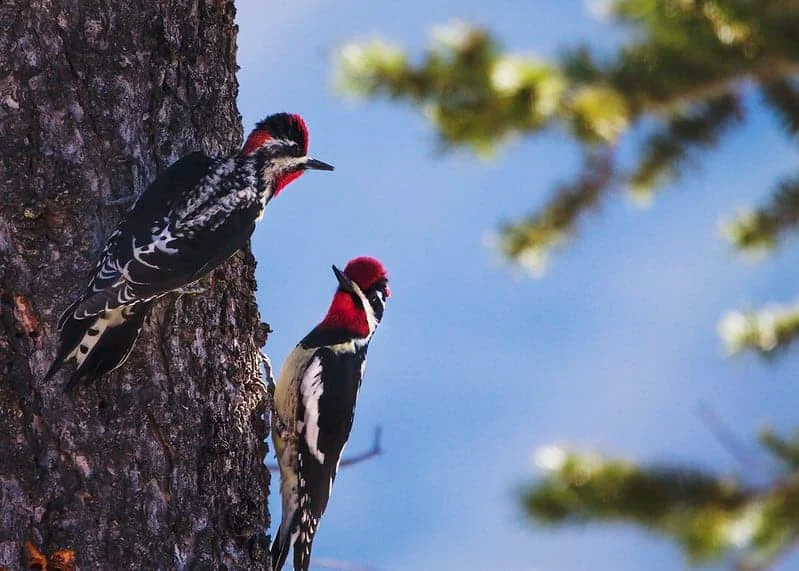
Wingspan
16.1-16.9 inches
Weight
32-66 g
Life Expectancy
5 Years
Diet
Insects
Red-naped Sapsuckers are medium birds with bright white markings on their wings that make them very distinguishable from other birds.
These woodpeckers also display a wide array of face patterns including black, white, and red.
They tend to nest in many types of trees while they prefer to nest in California’s riparian trees bordering forests.
These woodpeckers can be observed as they drill holes into tree trunks in search of food, although they nest in the cavities of trees.
You’ll most likely see these woodpeckers during their breeding season during the summer. These birds are identified by their ‘waa’ sounding call.
11. Acorn Woodpecker
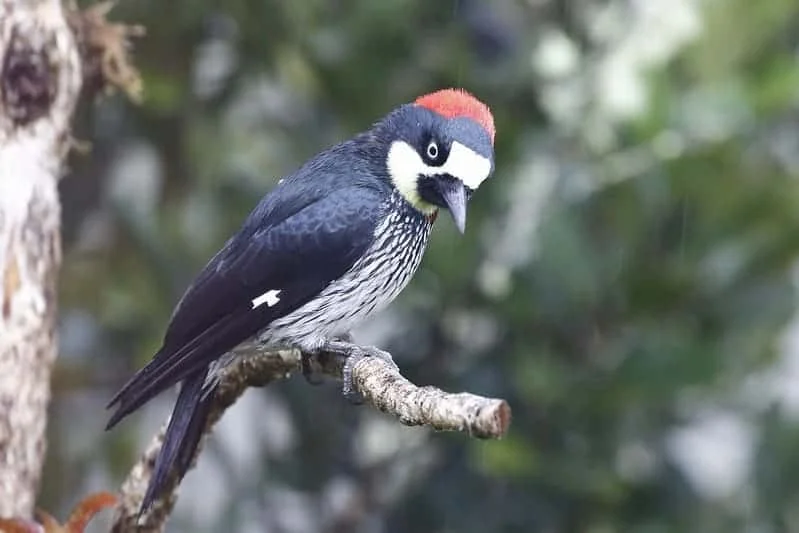
Wingspan
13.8-16.9 in
Weight
3.0 oz
Life Expectancy
10 Years
Diet
Acorns and Insects
Acorn Woodpeckers are classified as medium-sized birds, known for their striking face patterns and red crowns on the heads of both males and females.
Other interesting characteristics to note include their yellow foreheads and light-colored throats.
In California, these woodpeckers take habitat in oak groves where they prefer to collect and store their acorns.
Acorn Woodpeckers are even observed near man made wooden structures like fences and poles.
These woodpeckers tend to breed and nest in the summer and early fall when you can recognize them by their shrieking ‘waka-waka’ call.
12. Ladder-backed Woodpeckers
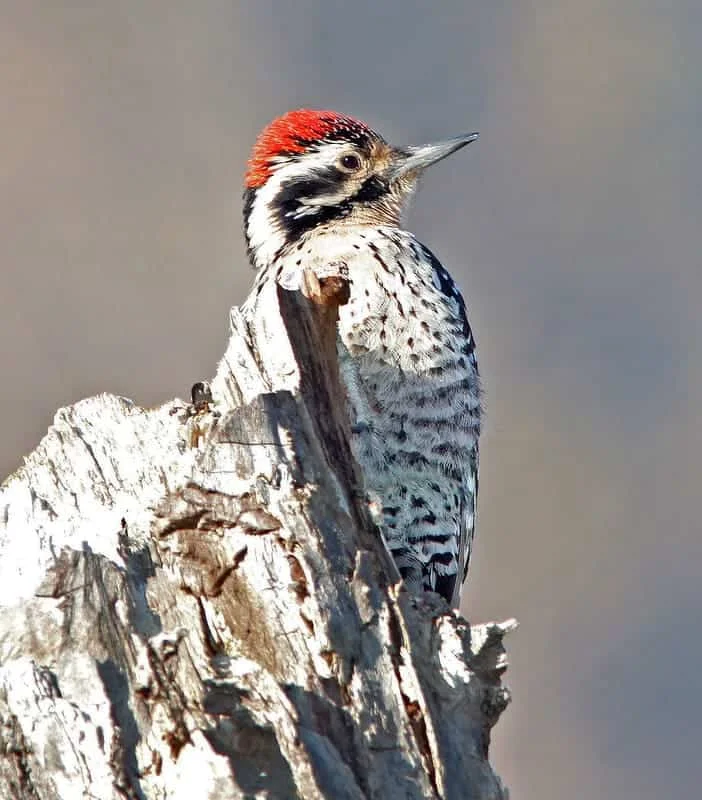
Wingspan
13 inches
Weight
0.7-1.7 oz
Life Expectancy
5 Years
Diet
Insects
Ladder-backed Woodpeckers are a particularly small species that are recognized for a unique pattern of dark and light striped feathers on their backs with spots on the breast.
Adult male Ladder-backed Woodpeckers display a red cap on their heads.
These woodpeckers make their homes in a variety of California habitats including cacti, scrubs, and forested areas.
Ladder-backed Woodpeckers have even been spotted during their spring breeding season as they visit backyard bird feeders.
You’ll notice that this species is particularly quiet, although you can easily identify them by their gentle ‘peek’ sound.
13. Red-Breasted Sapsucker
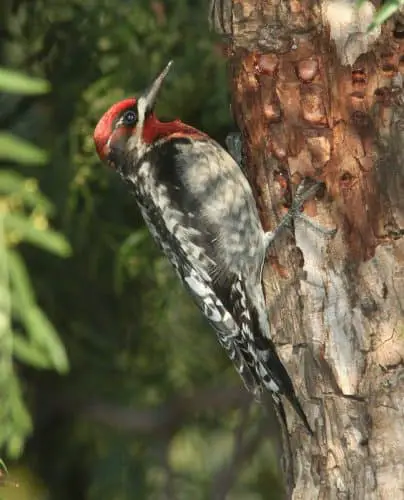
Wingspan
40cm
Weight
55g
Life Expectancy
2-3 Years
Diet
Insects
Red-Breasted Sapsuckers are medium woodpeckers that are known for their striking feather patterns.
These birds have red heads with a red breast, and a white stripe detailing the shoulder.
Some of these birds display black and white patterns on their heads, contrasting their black backs. The Red-breasted Sapsucker can be seen near California’s forest areas by the Rocky Mountain region.
These particular woodpeckers are migratory and some take habitat in the valleys of the Rocky Mountains during winter.
These birds have also been seen in residential neighborhoods near valleys.
The woodpeckers nest in tree trunks, but typically do not return to the same nesting site each year.
Red-breasted Sapsuckers are recognized by their fierce sounding ‘waah’ call in addition to their strange, irregular drumming patterns.
14. Gila Woodpecker
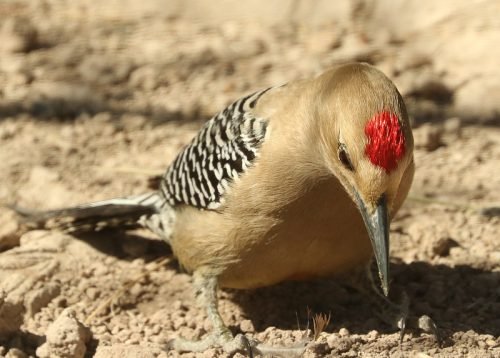
Wingspan
40cm
Weight
65g
Life Expectancy
10 Years
Diet
Insects
Gila Woodpeckers are medium birds with usually gray-brown feathers, but bold black and white patterns adorn their wings, tails, and backs.
Similar to other woodpecker species, only the mature adult birds have red caps. These birds are predominantly found in April, among cacti and large trees that provide adequate room for their nests.
Gila Woodpeckers also tend to be adaptable and are seen in residential areas as well.
These woodpeckers are quite noisy due to their habit of tapping on a variety of materials in order to attract the attention of a mate. Gila Woodpeckers also have a series of one-pitched, monotone calls.
15. Nuttall's Woodpeckers
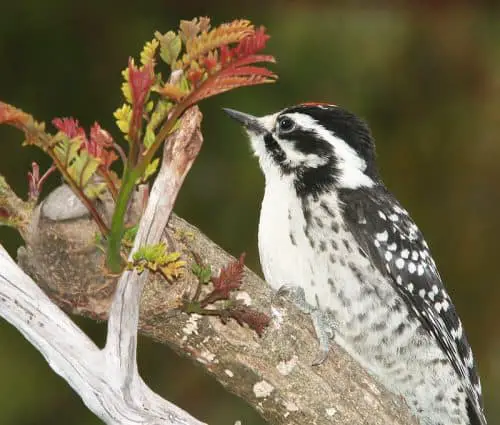
Wingspan
36cm
Weight
37g
Life Expectancy
8 Years
Diet
Insects
The Nuttall’s Woodpecker is a small species of woodpecker that is interestingly restricted to the state of California.
These woodpeckers display an easily identifiable pattern of black and white feathers on their backs and the males are distinguished by red caps on their heads.
You can easily spot Nutall’s Woodpeckers living near the Sierra Nevada Mountain near oak forests.
They can also be frequently spotted in residential areas visiting backyard feeders. Nuttall’s Woodpeckers are even observed during breeding season from January to March as they excavate their nests inside of willow, cottonwood, and oak trees.
These year-round residents are often easily recognized by their dry rattle sound and high octave ‘pit’ sounding call throughout the year
16. White-Headed Woodpecker
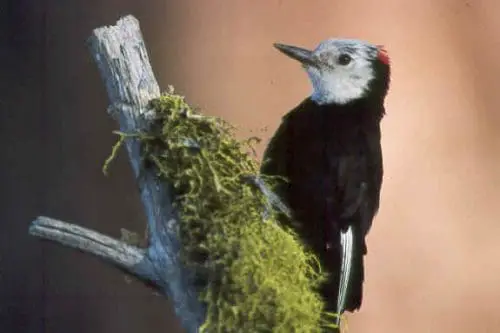
Wingspan
45cm
Weight
60g
Life Expectancy
4 Years
Diet
Insects
White-headed Woodpeckers are medium-sized woodpeckers, recognized for their unmistakable black and white head and small white patch on their wings.
However, males are distinguished by the red patch on their heads. These woodpeckers can be observed in coniferous forests close to mountains.
You can easily identify these birds, since they often travel in pairs or family groups.
White-headed Woodpeckers tend to breed in June while the male woodpeckers rest overnight in the tree cavity with juveniles.
These woodpeckers are recognized for their sharp ‘peek’ sound that is usually doubled and even tripled in speed!

More Articles.
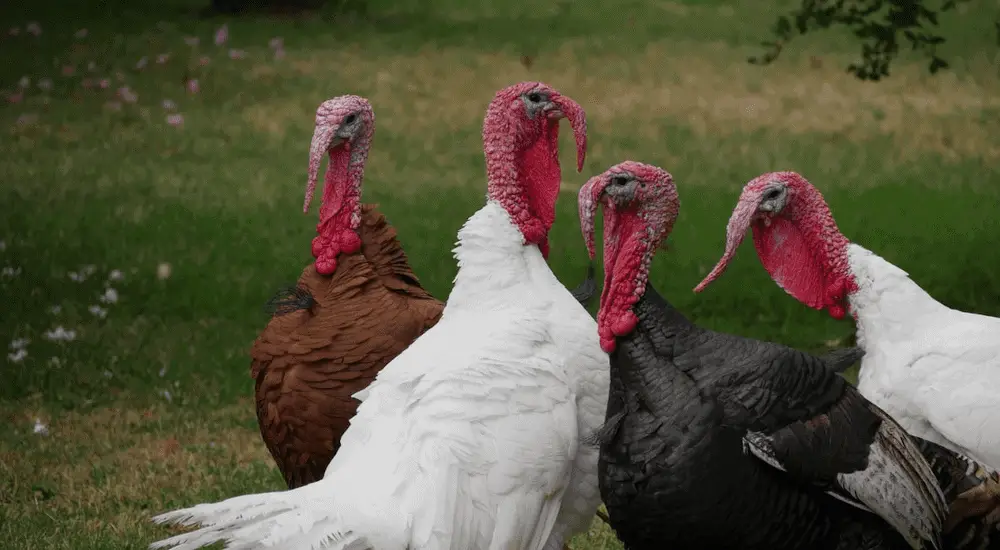
How to attract Wild Turkeys to your yard?
Wild turkeys can be provide quite a fascinating addition to your yard. Providing acorns in
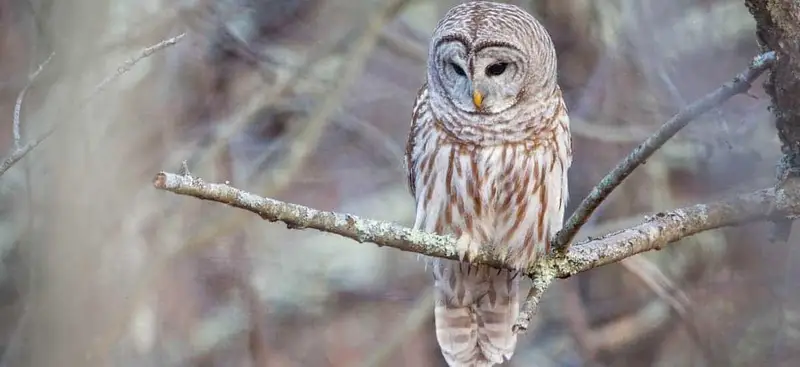
How to attract Owls to your yard?
The best way of attracting Owls to your yard is to offer them a nesting

Best Camera For Bird Watching 2020
Article Summary: Best Budget Camera: Nikon D500 DX-Format Digital SLR Best Mid-tier Camera: Canon EOS

About Us
We are avid bird-watchers who recently retired, allowing us more time to travel the world. Fortunately, we have managed to visit numerous countries around Europe, Asia, and America. Watching and photographing birds has been a passion for many years and we are making the most of the extra time on our hands!
